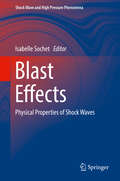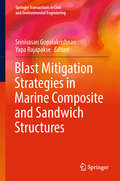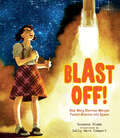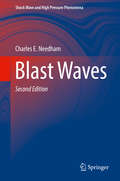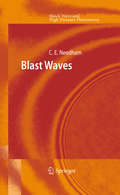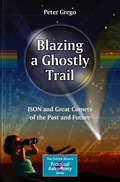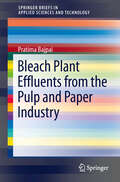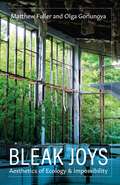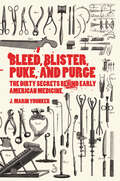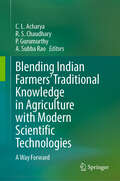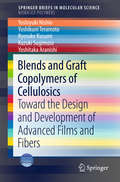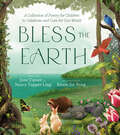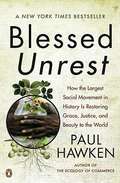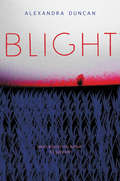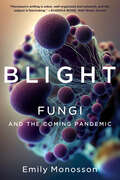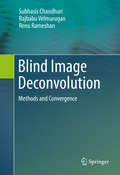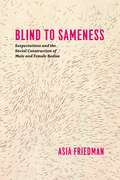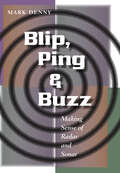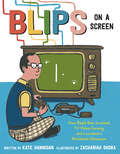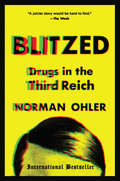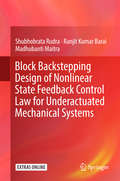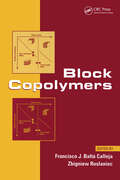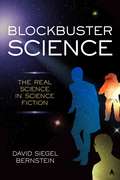- Table View
- List View
Blast Effects: Physical Properties of Shock Waves (Shock Wave and High Pressure Phenomena)
by Isabelle SochetThis book compiles a variety of experimental data on blast waves. The book begins with an introductory chapter and proceeds to the topic of blast wave phenomenology, with a discussion Rankine-Hugoniot equations and the Friedlander equation, used to describe the pressure-time history of a blast wave. Additional topics include arrival time measurement, the initiation of detonation by exploding wires, a discussion of TNT equivalency, and small scale experiments. Gaseous and high explosive detonations are covered as well. The topics and experiments covered were chosen based on the comparison of used scale sizes, from small to large. Each characteristic parameter of blast waves is analyzed and expressed versus scaled distance in terms of energy and mass. Finally, the appendix compiles a number of polynomial laws that will prove indispensable for engineers and researchers.
Blast Mitigation Strategies in Marine Composite and Sandwich Structures (Springer Transactions in Civil and Environmental Engineering)
by Srinivasan Gopalakrishnan Yapa RajapakseThis book primarily focuses on methodologies to enable marine structures to resist high velocity impact loadings. It is based on invited talks presented at the recent India-USA workshop on "Recent Advances in Blast Mitigation Strategies in Civil and Marine Composite Structures" The book comprises content from top researchers from India and the USA and covers various aspects of the topic, including modeling and simulation, design aspects, experimentation and various challenges. These failure modes significantly reduce the structural integrity of the marine structures unless they are designed to resist such harsh loadings. Understanding the mechanics of these structures under harsh loadings is still an open area of research, and the behavior of these structures is not fully understood. The book highlights efforts to reduce the effects of blast loadings on marine composite structures. Intended for researchers/scientists and practicing engineers, the book focuses not only the design and analysis challenges of marine composite structures under such harsh loading conditions, but also provides new design guidelines.
Blast Off!: How Mary Sherman Morgan Fueled America into Space
by Suzanne SladeThe inspirational story of Mary Sherman, the world's first female rocket scientist, who overcame gender barriers and many failures to succeed.Growing up in the 1920s on a dirt-poor farm in North Dakota, Mary Sherman's life was filled with chores--until she finally began school and discovered she loved to learn. Mary excelled at science, especially chemistry, and leaped at the chance to work in a laboratory during World War II designing rocket fuels. And when the US decided to enter the space race, Mary was chosen over her male colleagues to create the fuel to launch a rocket carrying America's first satellite. With courage and perseverance, Mary's hard work and calculations paid off, opening up a brand-new frontier for exploration. This STEM biography of an unsung and courageous woman in science will inspire and motivate young readers.
Blast Waves (Shock Wave and High Pressure Phenomena)
by Charles E. NeedhamAs an editor of the international scienti?c journal Shock Waves, I was asked whether I might document some of my experience and knowledge in the ?eld of blast waves. I began an outline for a book on the basis of a short course that I had been teaching for several years. I added to the outline, ?lling in details and including recent devel- ments, especially in the subjects of height of burst curves and nonideal explosives. At a recent meeting of the International Symposium on the Interaction of Shock Waves, I was asked to write the book I had said I was working on. As a senior advisor to a group working on computational ?uid dynamics, I found that I was repeating many useful rules and conservation laws as new people came into the group. The transfer of knowledge was hit and miss as questions arose during the normal work day. Although I had developed a short course on blast waves, it was not practical to teach the full course every time a new member was added to the group. This was suf?cient incentive for me to undertake the writing of this book. I cut my work schedule to part time for two years while writing the book. This allowed me to remain heavily involved in ongoing and leading edge work in hydrodynamics while documenting this somewhat historical perspective on blast waves.
Blast Waves (Shock Wave and High Pressure Phenomena)
by Charles E. NeedhamThe primary purpose of this text is to document many of the lessons that have been learned during the author's more than forty years in the field of blast and shock. The writing therefore takes on an historical perspective, in some sense, because it follows the author's experience. The book deals with blast waves propagating in fluids or materials that can be treated as fluids. It begins by distinguishing between blast waves and the more general category of shock waves. It then examines several ways of generating blast waves, considering the propagation of blast waves in one, two and three dimensions as well as through the real atmosphere. One section treats the propagation of shocks in layered gases in a more detailed manner. The book also details the interaction of shock waves with structures in particular reflections, progressing from simple to complex geometries, including planar structures, two-dimensional structures such as ramps or wedges, reflections from heights of burst, and three-dimensional structures. Intended for those with a basic knowledge of algebra and a solid grasp of the concepts of conservation of mass and energy, the text includes an introduction to blast wave terminology and conservation laws as well as a discussion of units and the importance of consistency.
Blazing a Ghostly Trail: ISON and Great Comets of the Past and Future (The Patrick Moore Practical Astronomy Series)
by Peter GregoIce and Fire: Great Comets to Come was written because a special celestial event climaxes towards the end of 2013 - the arrival, fresh from the Oort Cloud, of Comet C/2012 S1 (ISON). By all predictions - even the most pessimistic ones - this comet is set to be one of, perhaps the most, dazzling comet seen in modern history and has the astronomical world buzzing with anticipation. Skywatchers have already been primed for C/2012 (ISON) earlier in 2013 with the apparition of another naked-eye comet, C/2011 L4 (PanSTARRS), and following C/2012 S1 (ISON) there is the prospect of 2012 K1 (PanSTARRS) reaching naked eye visibility in August 2014. Future bright cometary prospects are also discussed, taking into account the latest predictions. Examining the origin and nature of comets using examples of great comets from the past, this book sets the scene for the arrival of Comet C/2012 S1 and those following it over the next few years in the inner Solar System. Skywatchers and amateur astronomers can learn how to follow, observe and record comets. There is also a guide on how to keep abreast of the latest cometary discoveries and how to use a variety of reputable sources, including publications, websites, programs and apps to visualize and plan observations. The role of the amateur in cometary discovery also is featured, as well as details on how professional astronomers plan to get the most 'science' out of cometary apparitions, how and why professionals go about discovering comets, and upcoming plans to visit comets with space probes (and later, perhaps, human visits). Illustrations provide historic images of comets, images from space probes and images of the latest bright comets. Orbital plots and easy-to-follow sky charts are also included. This book is a unique guide that sets the scene by giving a comprehensive history of comets and examples of great comets throughout history and informs the reader about the nature and origins of this spectacular occurence. Expectations are fully covered by explaining not only what the regular person can expect to see, but how amateur astronomers can plan observations and what steps the professionals are taking to 'get the most science' from this exciting event.
Bleach Plant Effluents from the Pulp and Paper Industry (SpringerBriefs in Applied Sciences and Technology)
by Pratima BajpaiThis book covers bleach plant effluents, that most polluting effluent from the pulp and paper industry. Disappearance of benthic invertebrates, a high incidence of fish diseases, and mutagenic effects on the aquatic fauna are some of the consequences of the disposal of bleach effluents into surface waters. This book describes environmental impact of bleach plant effluents, environmental regulations, and measures to reduce the pollution load by internal process modification and external treatment of bleach plant effluents.
Bleak Joys: Aesthetics of Ecology and Impossibility (Posthumanities #53)
by Matthew Fuller Olga GoriunovaA philosophical and cultural distillation of the bleak joys in today&’s ambivalent ecologies and patterns of lifeBleak Joys develops an understanding of complex entities and processes—from plant roots to forests to ecological damage and its calculation—as aesthetic. It is also a book about &“bad&” things, such as anguish and devastation, which relate to the ecological and technical but are also constitutive of politics, the ethical, and the formation of subjects.Avidly interdisciplinary, Bleak Joys draws on scientific work in plant sciences, computing, and cybernetics, as well as mathematics, literature, and art in ways that are not merely illustrative of but foundational to our understanding of ecological aesthetics and the condition in which the posthumanities are being forged. It places the sensory world of plants next to the generalized and nonlinear infrastructure of irresolvability—the economics of indifference up against the question of how to make a home on Planet Earth in a condition of damaged ecologies. Crosscutting chapters on devastation, anguish, irresolvability, luck, plant, and home create a vivid and multifaceted approach that is as remarkable for its humor as for its scholarly complexity.Engaging with Deleuze, Guattari, and Bakhtin, among others, Bleak Joys captures the modes of crises that constitute our present ecological and political condition, and reckons with the means by which they are not simply aesthetically known but aesthetically manifest.
Bleed, Blister, Puke, and Purge: The Dirty Secrets Behind Early American Medicine
by J. Marin YounkerRiots over the medical use of cadavers, public access to institutions for the insane, and full-blown surgeries without the aid of anesthetics or painkillers. Welcome to the middle ages of American medicine. Bleed, Blister, Puke, and Purge exposes the extraordinary practices and major players of American medical history, from America's colonial era to the late 1800s. It's hard to believe that today's cutting-edge medicine originated from such crude beginnings, but this book reminds us to be grateful for today's medical care, while also raising the question: what current medical practices will be the horrors of tomorrow?
Blending Indian Farmers' Traditional Knowledge in Agriculture with Modern Scientific Technologies: A Way Forward
by C. L. Acharya R. S. Chaudhary P. Gurumurthy A. Subba RaoThis book is a compilation of 37 chapters covering various agro ecosystems of India with respect to Indian farmers’ traditional knowledge and technology in agriculture specifically in nutrient management, crop production, water management and conservation, soil conservation and plant protection, which have been passed on from one generation to other since centuries. The book explains the scopes of blending this traditional knowledge with modern scientific technologies in agriculture with an aim of reducing production cost, improving soil health and use efficiency of costly market purchased inputs, water conservation and better environment. In the present era of continued degradation of natural resources of India, (primarily soil, water, and nutrients), falling soil health, poor use efficiency of agricultural inputs like fertilizer nutrients imported/ purchased at huge costs, it has become a big challenge to maintain the food production and simultaneously to sustain the soil health and productivity. The problem is further made complex by the changing climate, high levels of soil erosion and rising demands of ever-increasing population of the country for food, fodder, fibre, and fuel. In the face of such an alarming situation, the blending of low-cost traditional knowledge of Indian farmers and use of locally available inputs/ resources with the modern scientific technologies in agriculture, is seen as a major hope in increasing the input use efficiency, protection/conservation of the soil, water and nutrients towards sustainable crop production and food security without compromising the soil health. The book will be of interest to the scientists/researchers, extension workers, capacity builders, planners, government administrators, teachers, and students.
Blends and Graft Copolymers of Cellulosics: Toward the Design and Development of Advanced Films and Fibers (SpringerBriefs in Molecular Science)
by Yoshiyuki Nishio Yoshikuni Teramoto Ryosuke Kusumi Kazuki Sugimura Yoshitaka AranishiThis book reveals how polymer blending and grafting now offer a growing range of new applications for advanced films and fibers. Further, it details how the processing and original physical properties of cellulosics can be improved, and demonstrates how new, cellulose-core polymeric materials offer a wide range of synergistic functionalities. Lastly, it summarizes basic characterization studies and successful fabrications of advanced films and fibers. The book is primarily intended for advanced undergraduates, academic and industrial researchers and professionals studying or using bio-based polymers.
Bless the Earth: A Collection of Poetry for Children to Celebrate and Care for Our World
by June Cotner Nancy Tupper LingA beautifully illustrated collection of poems and prayers to help children develop an appreciation for the natural worldBless the Earth, our faithful friend,her mountain range and river bend,her forest green and canopy,the hidden world of bended trees. Bless the Earth shows the miracle of our planet Earth through beautiful imagery and delightful poetry, calling all people, young and old, to care for our wonderful world. This sweet and welcoming anthology for children ages 3-7 knits together our common humanity and the natural world in an engaging way that is simple for young readers to understand.Bless the Earth contains approximately sixty selections of original as well as classic poems, divided into five chapters each:Dreams for My WorldEarth and SkyAll Creatures, Big and SmallSeasonsCaring for Our World Bless the Earth calls us again and again to understand how important it is to care for our world, respect our neighbors—humans, plants, and animals alike—and reimagine a world that is healthy and whole.
Blessed Unrest
by Paul HawkenOrganizations working to restore the environment and foster social justice collectively comprise the largest movement on earth. This movement with no name, leader, or location is a creative expression of people's needs worldwide.
Blight
by Alexandra DuncanWhen an agribusiness facility producing genetically engineered food releases a deadly toxin into the environment, seventeen-year-old Tempest Torres races to deliver the cure before time runs out.From the author of the acclaimed American Booksellers Association’s Indies Introduce pick Salvage, which was called “Brilliant, feminist science fiction” by Stephanie Perkins, the internationally bestselling author of Anna and the French Kiss. This stand-alone action-adventure story is perfect for fans of Oryx and Crake and The House of the Scorpion. Seventeen-year-old Tempest Torres has lived on the AgraStar farm north of Atlanta, Georgia, since she was found outside its gates at the age of five. Now she’s part of the security force guarding the fence and watching for scavengers—people who would rather steal genetically engineered food from the Company than work for it. When a group of such rebels accidentally sets off an explosion in the research compound, it releases into the air a blight that kills every living thing in its path—including humans. With blight-resistant seeds in her pocket, Tempest teams up with a scavenger boy named Alder and runs for help. But when they finally arrive at AgraStar headquarters, they discover that there’s an even bigger plot behind the blight—and it’s up to them to stop it from happening again.Inspired by current environmental issues, specifically the genetic adjustment of seeds to resist blight and the risks of not allowing natural seed diversity, this is an action-adventure story that is Margaret Atwood’s Oryx and Crake meets Nancy Farmer’s House of the Scorpion.
Blight: Fungi and the Coming Pandemic
by Emily MonossonWinner of the 2024 Phi Beta Kappa Award for Science A New York Times Editors' Choice A Science News Favorite Book of 2023 "Fungi sicken us and fungi sustain us. In either case, we ignore them at our peril." —Elizabeth Kolbert, New York Review of Books A prescient warning about the mysterious and deadly world of fungi—and how to avert further loss across species, including our own. Fungi are everywhere. Most are harmless; some are helpful. A few are killers. Collectively, infectious fungi are the most devastating agents of disease on earth, and a fungus that can persist in the environment without its host is here to stay. In Blight, Emily Monosson documents how trade, travel, and a changing climate are making us all more vulnerable to invasion. Populations of bats, frogs, and salamanders face extinction. In the Northwest, America’s beloved national parks are covered with the spindly corpses of whitebark pines. Food crops are under siege, threatening our coffee, bananas, and wheat—and, more broadly, our global food security. Candida auris, drug-resistant and resilient, infects hospital patients and those with weakened immune systems. Coccidioides, which lives in drier dusty regions, may cause infection in apparently healthy people. The horrors go on. Yet prevention is not impossible. Tracing the history of fungal spread and the most recent discoveries in the field, Monosson meets scientists who are working tirelessly to protect species under threat, and whose innovative approaches to fungal invasion have the potential to save human lives. Delving into case studies at once fascinating, sobering, and hopeful, Blight serves as a wake-up call, a reminder of the delicate interconnectedness of the natural world, and a lesson in seeing life on our planet with renewed humility and awe.
Blind Image Deconvolution: Methods and Convergence
by Subhasis Chaudhuri Rajbabu Velmurugan Renu RameshanBlind deconvolution is a classical image processing problem which has been investigated by a large number of researchers over the last four decades. The purpose of this monograph is not to propose yet another method for blind image restoration. Rather the basic issue of deconvolvability has been explored from a theoretical view point. Some authors claim very good results while quite a few claim that blind restoration does not work. The authors clearly detail when such methods are expected to work and when they will not. In order to avoid the assumptions needed for convergence analysis in the Fourier domain, the authors use a general method of convergence analysis used for alternate minimization based on three point and four point properties of the points in the image space. The authors prove that all points in the image space satisfy the three point property and also derive the conditions under which four point property is satisfied. This provides the conditions under which alternate minimization for blind deconvolution converges with a quadratic prior. Since the convergence properties depend on the chosen priors, one should design priors that avoid trivial solutions. Hence, a sparsity based solution is also provided for blind deconvolution, by using image priors having a cost that increases with the amount of blur, which is another way to prevent trivial solutions in joint estimation. This book will be a highly useful resource to the researchers and academicians in the specific area of blind deconvolution.
Blind to Sameness: Sexpectations and the Social Construction of Male and Female Bodies
by Asia FriedmanWhat is the role of the senses in how we understand the world? Cognitive sociology has long addressed the way we perceive or imagine boundaries in our ordinary lives, but Asia Friedman pushes this question further still. How, she asks, did we come to blind ourselves to sex sameness? Drawing on more than sixty interviews with two decidedly different populations—the blind and the transgendered—Blind to Sameness answers provocative questions about the relationships between sex differences, biology, and visual perception. Both groups speak from unique perspectives that magnify the social construction of dominant visual conceptions of sex, allowing Friedman to examine the visual construction of the sexed body and highlighting the processes of social perception underlying our everyday experience of male and female bodies. The result is a notable contribution to the sociologies of gender, culture, and cognition that will revolutionize the way we think about sex.
Blinded By The Light: The Secret Life of the Sun
by John GribbinIn investigation into the study of the sun.
Blip, Ping, and Buzz: Making Sense of Radar and Sonar
by Mark DennyHave you ever wondered how stealth planes achieve "invisibility," how sunken ships are found, or how fishermen track schools of fish in vast expanses of ocean? Radar and sonar echolocation—a simple matter of sending, receiving, and processing signals.Weaving history with simple science, Mark Denny deftly reveals the world of radar and sonar to the curious reader, technology buff, and expert alike. He begins with an early history of the Chain Home radar system used during World War II and then provides accessible and engaging explanations of the physics that make signal processing possible. Basic diagrams and formulas show how electromagnetic and sound waves are transmitted, received, and converted into images, allowing you to literally see in the dark.A section on bioacoustic echolocation, with a focus on the superior sonar systems of bats and whales and a discussion of the advanced technology of next-generation airborne signal processors, opens the imagination to fascinating possibilities for the future.
Blips on a Screen: How Ralph Baer Invented TV Video Gaming and Launched a Worldwide Obsession
by Kate HanniganAn engaging picture book biography based on the incredible true story of a Jewish refugee who pioneered home video games and launched a worldwide obsession.Do you ever wonder how video gaming was invented? What came before your PlayStation or Xbox? This is the story of Ralph Baer, a refugee from Nazi Germany, who used his skills--and a lot of ingenuity and persistence--to make life a little more fun. Television was new when Ralph returned from serving in World War II, but he didn't settle for watching TV. He knew it could be even more fun if you could play with it. He tinkered and tested, got help and rejected, but with perseverance and skill, he made his vision come true! This is the inspiring story of a fearless inventor who made TV video games a reality.
Blitzed: Drugs in the Third Reich
by Norman OhlerA New York Times bestseller, Norman Ohler's Blitzed is a "fascinating, engrossing, often dark history of drug use in the Third Reich” (Washington Post). The Nazi regime preached an ideology of physical, mental, and moral purity. Yet as Norman Ohler reveals in this gripping history, the Third Reich was saturated with drugs: cocaine, opiates, and, most of all, methamphetamines, which were consumed by everyone from factory workers to housewives to German soldiers. In fact, troops were encouraged, and in some cases ordered, to take rations of a form of crystal meth—the elevated energy and feelings of invincibility associated with the high even help to account for the breakneck invasion that sealed the fall of France in 1940, as well as other German military victories. Hitler himself became increasingly dependent on injections of a cocktail of drugs—ultimately including Eukodal, a cousin of heroin—administered by his personal doctor. Thoroughly researched and rivetingly readable, Blitzed throws light on a history that, until now, has remained in the shadows. “Delightfully nuts.”—The New Yorker
Block Backstepping Design of Nonlinear State Feedback Control Law for Underactuated Mechanical Systems
by Ranjit Kumar Barai Shubhobrata Rudra Madhubanti MaitraThis book presents a novel, generalized approach to the design of nonlinear state feedback control laws for a large class of underactuated mechanical systems based on application of the block backstepping method. The control law proposed here is robust against the effects of model uncertainty in dynamic and steady-state performance and addresses the issue of asymptotic stabilization for the class of underactuated mechanical systems. An underactuated system is defined as one for which the dimension of space spanned by the configuration vector is greater than that of the space spanned by the control variables. Control problems concerning underactuated systems currently represent an active field of research due to their broad range of applications in robotics, aerospace, and marine contexts. The book derives a generalized theory of block backstepping control design for underactuated mechanical systems, and examines several case studies that cover interesting examples of underactuated mechanical systems. The mathematical derivations are described using well-known notations and simple algebra, without the need for any special previous background in higher mathematics. The chapters are lucidly described in a systematic manner, starting with control system preliminaries and moving on to a generalized description of the block backstepping method, before turning to several case studies. Simulation and experimental results are also provided to aid in reader comprehension.
Block Co-polymeric Nanocarriers: Design, Concept, and Therapeutic Applications
by Neeraj Mishra Vikas PandeyThis book focuses on current advancements in the field of block copolymers and covers design, concept, and various therapeutic applications in the drug delivery. It also reviews the use of block copolymers in drug delivery applications from the development of sustained release products to smart polymeric delivery systems such as stimuli-responsive polymeric systems, for example, thermosensitive, redox-sensitive, photo-sensitive, and enzyme-sensitive. The book further discusses the nano assemblies from amphiphilic block copolymers as nanomedicine platforms for diagnosis and therapy due to their relatively small size, high drug loading capacity, controlled drug release, in vivo stability, and prolonged blood circulation. The chapters also review the various patents and ongoing clinical trials on the applications, covering several important new concepts and findings in the field of block copolymers. The book is aimed at researchers, academicians, and industrial scientists involved in the development of drug-delivery systems based on polymers.
Block Copolymers
by Francisco J. Baltá Calleja Zbigniew RoslaniecA summary of block copolymer chemical structures and synthesis. It discusses physical methods of characterization such as computer simulation, microhardness, dielectric spectroscopy, thermal mechanical relaxation, ultrasonic characterization, transmission electron microscopy, X-ray scattering, and NMR, among others. It also outlines rheological and
Blockbuster Science: The Real Science in Science Fiction
by David Siegel BernsteinIf you've ever wondered how much real science goes into movies like Gravity, novels like The Martian, and television shows like Doctor Who, this is the book for you. Written by an author who is both a data scientist and a science fiction writer, this entertaining and accessible book uses popular science fiction movies, stories, and TV shows to explain the science behind popular narrative concepts like time travel, lightsabers, AI, genetic mutation, asteroids, cyborgs, black holes, alien invasion, the zombie apocalypse, and more.What could be a more fun way to explore the world of science than through its use—accurately or fantastically—in science fiction entertainment: movies, books, and TV shows?Learn about relativity through Orson Scott Card's Ender's Game and the movie Interstellar; black holes and wormholes in connection with Contact and Planet of the Apes; theories about the origin of life as reflected in Battlestar Galactica, Star Trek: The Next Generation, and The Hitchhiker's Guide to the Galaxy; computer science and artificial intelligence in reference to A.I. Artificial Intelligence; and much, much, more.Written with wit, clarity, and a great sense of fun, Blockbuster Science will inspire science fiction fans to get excited about real science while also putting an engaging pop culture spin on science for any curious reader.
